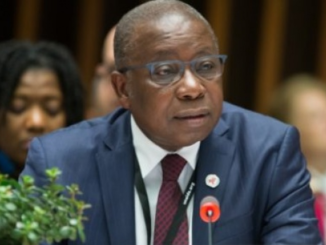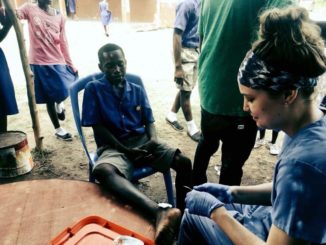Ghana is a politically, economically, ethnically and demographically diverse country. The origins of economic and social inequality between the north and south of Ghana are largely due to geography and historical legacies of inequality established in colonial times. Still, the country had and has been successful in preventing tensions and conflicts, in part because Ghanaian government has maintained ethno-regional balances in representation.
The most recent Systemic Country Diagnostic for Ghana, Priorities for Ending Poverty and Boosting Shared Prosperity, analyzed the country’s historical development path to identify achievements and challenges and opportunities to establish potential pathways to the future. Ghana’s economic growth rate stabilized in the early 1990s and induced a development momentum that allowed the country to achieve lower middle-income status in 2011. Ghana grew at 1.9% per year on average between 1993 and 2005, and 4.5% per year after 2005 (Figure 1(a)), considerably above the averages for non-high-income Sub-Saharan African countries (2%) and for low-income countries (2.6%), and slightly above lower-middle-income countries (LMICs) at 4.4%. This acceleration was in part due to higher prices for Ghana’s main commodity exports, notably gold and cocoa, and the start of commercial oil production in 2011. After a peak in 2011, growth declined to a mere 1.6% in 2015 due to a combination of declining commodity prices, energy rationing, and a fiscal crisis in 2013. Since 2015, growth picked up, and the country’s gross domestic product (GDP) grew 8.5% in 2017.
This growth momentum helped place Ghana at the forefront of poverty reduction in Africa. The country achieved the first Millennium Development Goal (MDG) of reducing the national poverty rate by more than half, from 52.7% in 1991 to 24.2% in 2012., Ghana’s international poverty headcount, which was higher than the average LMIC poverty rate in the 1990s, is lower today at 13.6% compared to 18.3%. The national poverty rate declined by a record 12.2 percentage points during 1991–1998, by 11 points during 1998–2005, and by 7.7 percentage points during 2005-2012. Then poverty reduction slowed dramatically to only by 0.8 percentage points during 2012–2016, reflecting a fundamental change in the pattern and drivers of growth.
Figure 1: Trends in GDP Growth and Poverty
| (a) Ghana GDP (Constant 2010 US$), US$ billion | (b) Poverty rate using National Poverty Line (%), 1991–2012 |
 |
 |
Source: World Bank, World Development Indicators (WDI), and Ghana Living Standards Survey (GLSS3–6).
Faster growth after 1990 reflects increasing productivity and human capital accumulation, which overtook labor accumulation as drivers of growth. Human capital accumulation, in terms of labor and education, was the main factor contributing to growth in 1970–1990 ( Figure 2 ). Total factor productivity (TFP) growth has been particularly strong between 1991 and 2005; since 2005, fixed capital investment became the primary driver as investments in the natural resource sector soared.
Figure 2: Ghana Growth Accounting, 1970–2016

Increased agricultural production and human capital development helped deliver Ghana’s rapid and steady decline in poverty. Poverty rates among cocoa farmers declined from 60% in 1991 to 24% in 2005. Food production doubled during this period. Meanwhile, Ghana embarked on a major expansion in education. Primary school enrollment rose from 66 to 89% during 1990–2016; and secondary enrollment rose from 36 to 62%. Between 1991 and 2012, the share of workers without schooling almost halved, and by 2012 many workers had completed junior secondary education. Each additional year of education is associated with a 6–10% increase in earnings.
At the same time, Ghana went through a significant structural transformation and a rapid urbanization. The share of employment in agriculture fell from 62% in 1991 to 42% in 2015 as it rose from 28 to 43% in services. Service replaced agriculture as the largest sector of the economy. Meanwhile, industry saw its share decline to the level where it had been in 1960, just 5.5% of GDP. Ghana has also experienced rapid urbanization that is associated with the shift of labor into services. The share of the population living in urban areas rose from 36% to 55% during 1990–2016.
The country’s progress was reflected in improved indicators of human capital development. Life expectancy is now 62 years. Ghana’s Human Development Index rose 27% during 1990–2016. Fertility decreased from 6.2 births per 1,000 women to 4.2 during 1988–2014, reducing Ghana’s dependency ratio; the share of births attended by skilled personnel rose from 40 to 74%; under-5 mortality declined by more than half. Gender parity has been achieved in primary education. Just under 85% of the population has access to improved water sources and 81% to electricity in 2016/17 (up from 45% in 2005/06).
This blog is the first in a three-part series to present the key findings of the Systemic Country Diagnostic for Ghana, Priorities for Ending Poverty and Boosting Shared Prosperity along three areas: achievements, challenges and opportunities and pathways for the future.
SUBMITTED BY MICHAEL GEIGER ON MON, 12/10/2018
–
Credit: http://blogs.worldbank.org/




